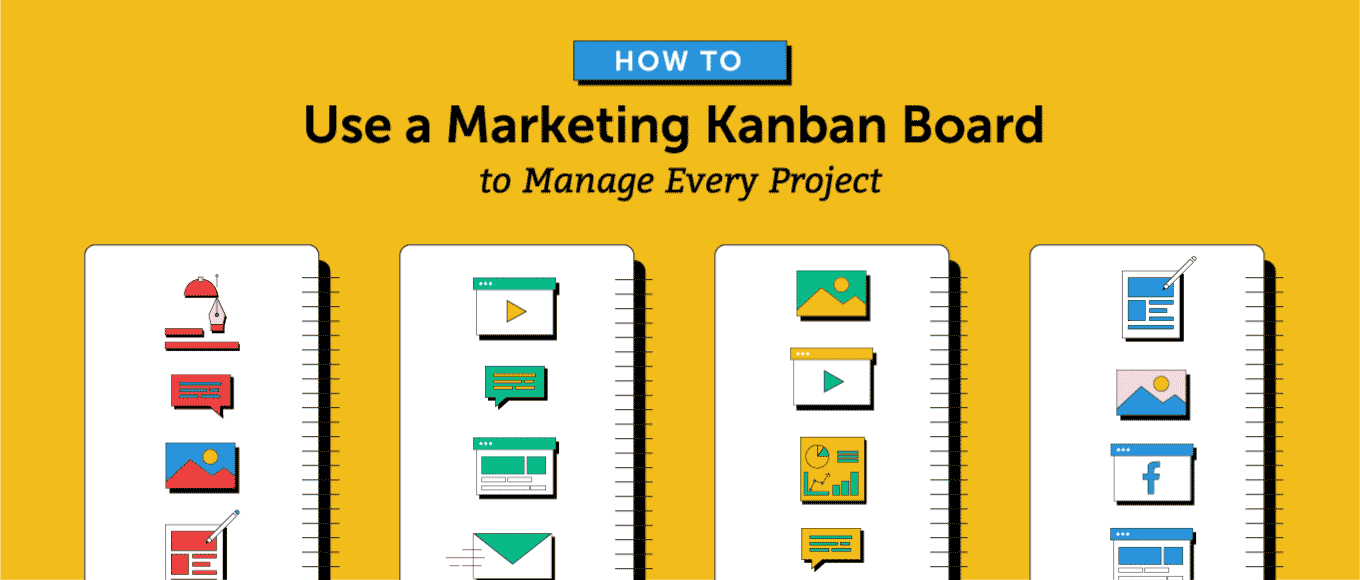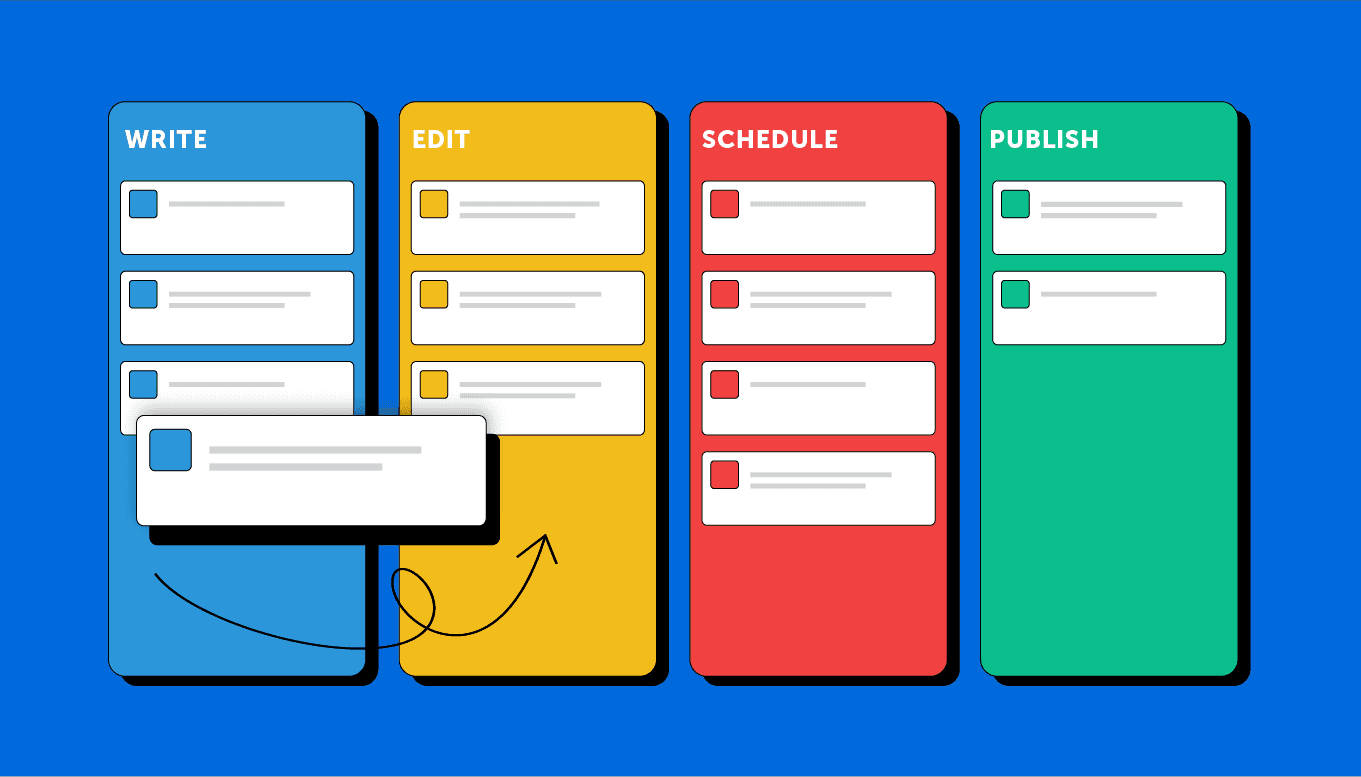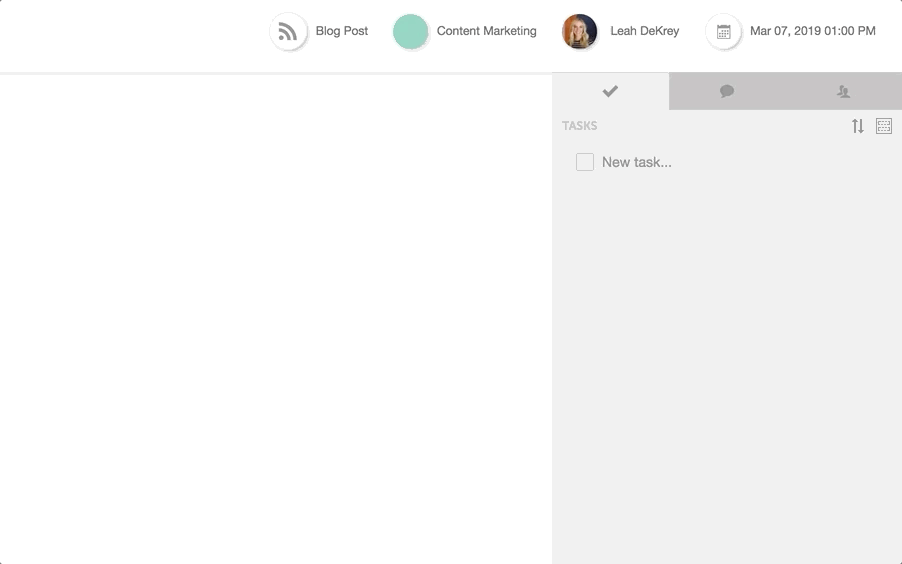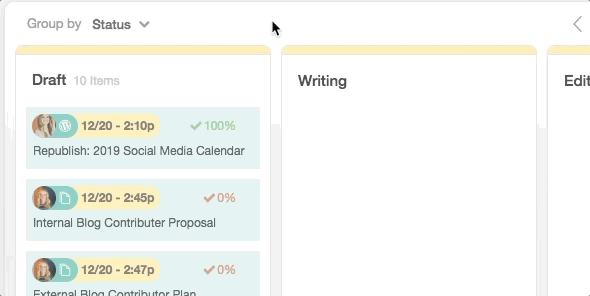How to Use a Marketing Kanban Board to Manage Every Project
 As marketers, we have a lot on our plates at all times. Our teams don’t just execute campaigns; they fuel successful launches and grow customer loyalty.
And that’s what makes it challenging.
There’s always so much to do. So many concurrent projects and moving pieces. When you’re in charge of getting things done, it’s easy to feel disorganized.
What is everyone working on? Why did we miss a deadline last month, and what can we do to prevent it? Can we streamline our tasks instead of trying to do everything at once?
Take a deep breath. There’s a way to keep all your marketing projects on track with a simple, but powerful method: a marketing kanban board.
As you’ll soon see, this is a gamechanger. In this guide, you’ll learn:
As marketers, we have a lot on our plates at all times. Our teams don’t just execute campaigns; they fuel successful launches and grow customer loyalty.
And that’s what makes it challenging.
There’s always so much to do. So many concurrent projects and moving pieces. When you’re in charge of getting things done, it’s easy to feel disorganized.
What is everyone working on? Why did we miss a deadline last month, and what can we do to prevent it? Can we streamline our tasks instead of trying to do everything at once?
Take a deep breath. There’s a way to keep all your marketing projects on track with a simple, but powerful method: a marketing kanban board.
As you’ll soon see, this is a gamechanger. In this guide, you’ll learn:
- How to build a central hub for all your marketing projects for ultimate team transparency and project visibility.
- The best way to anticipate bottlenecks and delays (and fix them before they happen).
- The day-to-day project management practice that will empower your team and help you streamline your processes.
How to Use a Marketing Kanban Board to Manage Every Project by @MarijanaKay via @CoSchedule
Click To TweetDownload Your Kanban + Agile Marketing Templates
Make getting started with kanban and agile marketing easy with this collection of templates:What is a Kanban Board?
A kanban board is a visual overview of steps involved in a project. It enables you to move projects through workflow stages, from left to right (from beginning to end). The concept of kanban was introduced by Toyota in 1940s when their manufacturing teams started using cards to signal that part of a production line needed more parts. The name kanban makes sense—the Japanese word “kanban” translates to “billboard” or “signboard.”
Marketing teams are packed with diverse skill sets and manage multiple projects all at once. To hit their deadlines, they need a strong, reliable hub of everything going on.
A marketing kanban board is a framework within agile marketing, which focuses on rapid iteration and data-backed decision-making. Here’s how you and your team can work better, faster, and at less cost thanks to kanban.
The concept of kanban was introduced by Toyota in 1940s when their manufacturing teams started using cards to signal that part of a production line needed more parts. The name kanban makes sense—the Japanese word “kanban” translates to “billboard” or “signboard.”
Marketing teams are packed with diverse skill sets and manage multiple projects all at once. To hit their deadlines, they need a strong, reliable hub of everything going on.
A marketing kanban board is a framework within agile marketing, which focuses on rapid iteration and data-backed decision-making. Here’s how you and your team can work better, faster, and at less cost thanks to kanban.
Here’s how you and your team can work better, faster, and at less cost thanks to kanban.
Click To TweetBuilding Blocks of a Marketing Kanban Workflow
Your marketing team’s kanban workflow is made of three essential elements:- Kanban board: The main overview of the entire workflow, a central place where all processes live.
- Kanban list: Individual list that represents a well-defined stage of a process. When a card is on a certain kanban list, that list indicates the current status of a project.
- Kanban card: The visual representation of a deliverable, such as a campaign, a blog post, a product launch, and so on. You can drag-and-drop a card between lists.

Why Should Agile Marketing Teams Use a Kanban Board?
Kanban boards aren’t just a cool-looking tool for managing your marketing projects. Here are some tangible benefits that come with managing your projects visually in a kanban workflow.Get a Pulse on Every Project
If you’re sending emails or Slack messages just to check in on a project with a team member, you’ll love a marketing kanban board. Consider this: sending that message requires you to step away from your work and makes your team member step away from theirs. This jumping between tasks is called context switching, and it can take up to 25 minutes to resume a task after interruption. In other words, you may want to move the project forward, but your checking in actually delays it more. Kanban board is a brilliant alternative. At a glance, you can view where each project is in real-time and without clogging anyone’s inbox.Find Bottlenecks in Your Workflow
Let’s say your writers are super productive and deliver their drafts ahead of time. However, you miss your blog post publish date almost weekly. How can that be? With a visual overview of all workflow stages, you can see exactly why that happens. A bottleneck happens when a stage that gets more requests than it can process on time, which makes projects pile up and block your workflow. This is how a bottleneck could look like on a marketing kanban board:- Write: 3 cards
- Design: 2 cards
- Edit: 8 cards
- Final approval: 1 card
- Publish: 2 cards
- Reassign some of your team members to help with the overflow.
- Analyze the stages prior to editing. Are editors receiving drafts that aren’t in good enough shape?
Run Efficient Meetings
According to Harvard Business Review, 65% of senior managers say meetings keep them from completing their own work, and 71% said meetings are unproductive and inefficient. We assume it’s not too different outside of management, too. This is a glass-half-full situation: it means we can do meetings better. Kanban system gives everyone on the team a transparent overview of what’s going on, so you can run standing meetings that let your team share:- Tasks they completed yesterday.
- Tasks they’re working on today.
- Roadblocks they’re facing.
7 Most Important Kanban Board Features
You can have your marketing kanban board in various software tools, like task management software, a project management platform, and more. You can also do it in a tangible form with a whiteboard and sticky notes, but as you’ll soon see, there are limitations to that. Online kanban boards are the only ones offering the below benefits. In your marketing kanban board, you’ll want to...Easily Move Cards Between Kanban Lists
A drag-and-drop capability is the signature feature of any kanban board. When your customer newsletter is written and ready for design, you’ll want to move it there in under a second.
Assign Kanban Cards to Your Team Members
A clear sense of ownership is essential to move projects forward on time. Who owns the project in which stage of the workflow? This is particularly important if you have multiple people doing similar tasks, such as a team of graphic designers. Card ownership creates transparency and sets clear expectations. Here’s what card ownership looks like in CoSchedule’s Kanban Project Dashboard:
Add Contributors to a Card and Create a Space For Conversations
Card ownership doesn’t mean no one else is involved in the process. This is where contributors and conversations are a vital kanban board capability. Once you have the right contributors added to a project, you’ve also created a space for project-specific discussion, comments, and notes. Contributors can exchange feedback and suggestions quickly without clogging up their email inboxes or Slack notifications.
Once you have the right contributors added to a project, you’ve also created a space for project-specific discussion, comments, and notes. Contributors can exchange feedback and suggestions quickly without clogging up their email inboxes or Slack notifications.

Add Checklists to Cards (and Templatize Them)
Checklists ensure no steps in the process are missed. You can create your project workflow once and turn it into a reusable template. In CoSchedule, you can do this with Task Templates and create as many as you need based on different types of campaigns and tasks involved. Check it out: Want to know more about why checklists are game-changing? Surgeon and author Atul Gawande wrote the book The Checklist Manifesto and spoke about the value of checklists in his TED talk:
https://youtu.be/55Nc8nccPa0
If checklists have the power to reduce death rates in hospitals, they can definitely help you hit your marketing goals.
Want to know more about why checklists are game-changing? Surgeon and author Atul Gawande wrote the book The Checklist Manifesto and spoke about the value of checklists in his TED talk:
https://youtu.be/55Nc8nccPa0
If checklists have the power to reduce death rates in hospitals, they can definitely help you hit your marketing goals.
Add Labels or Tags to Your Kanban Cards
With kanban boards, you can easily keep an eye on all current and upcoming projects. You can supercharge this benefit with additional labeling. You can use tagging to differentiate your campaigns by:- Funnel stage
- Persona
- Goal
- Freelancer/agency vs. in-house project

Easily Search Through Cards
If you have a small team and never more than a dozen cards on your kanban board, you won’t struggle to find them. But as you and your team grow, that won’t be the case anymore. With a search function, everything will stay a click away no matter how many projects or team members you have.
Add Dates to Cards and View Them on a Calendar
Your marketing kanban board gives you a linear view of your project workflows, but it doesn’t show you how various projects relate to each other on a calendar. Even campaigns within a same workflow stage could be weeks apart with launch dates. Look for a tool that allows you to give each card a due date. Remember CoSchedule’s Task Templates from earlier? When your card has a date, tasks on your checklist will also have dates based on how many days before the deadline you need to complete them.
Creating Your Marketing Kanban Board in 5 Simple Steps
Now you’re ready to get to work and build a kanban board for your marketing team. Here are the steps you can easily follow.1. Create an Idea Backlog
Most successful projects are those you brainstorm, validate, and plan well before they hit the calendar. Ideas for campaigns can come to you from many directions:- Dedicated content brainstorming sessions
- Inbound requests
- Market and customer research
 Use an idea kanban board to flesh out content topics worth pursuing and trash those that aren’t.
Don’t keep your content ideas in your head. When you do, you’re the victim of Zeigarnik effect, which is our tendency to remember uncompleted or interrupted tasks better than those we completed.
With an idea board, you can unload ideas when they come to you, get back to your work, and triage those ideas later.
Use an idea kanban board to flesh out content topics worth pursuing and trash those that aren’t.
Don’t keep your content ideas in your head. When you do, you’re the victim of Zeigarnik effect, which is our tendency to remember uncompleted or interrupted tasks better than those we completed.
With an idea board, you can unload ideas when they come to you, get back to your work, and triage those ideas later.
2. List Custom Statuses For Your Content Pipeline
Identify the stages in your content workflow. These are the custom statuses your projects (such as blog posts, email campaigns, ebooks) go through. For example, here are the project statuses you could be working with regularly:- Not started: Projects yet to be started.
- Draft: The project is being written.
- Design: The creation of visual assets based on the draft.
- Edit: Revising and proofreading the draft with visual assets built in.
- Scheduled: The project has been approved and scheduled.
- Published: The project is now live.
3. Turn Project Statuses Into Kanban Lists On Your Marketing Board
Add all your custom project statuses to a kanban board and arrange them in a chronological way, from left (project beginning) to right (project completion).
4. Build Checklists For Each Project Status
Each workflow status has a list of tasks that need to be completed before it can be considered done. For example, the Draft status could include these tasks:- Keyword research.
- Content research.
- Write WIIFM (what’s in it for me?).
- Write outline.
- Write draft.
- Add links.
- Add metadata.
- Research similar content.
- Review branding guidelines.
- Design in-line graphics.
- Design feature image.
- Design social media graphics.
- Proofread content.
- Check headline score.
- Double-check metadata.
- Review on-page SEO elements.
- List every step required to complete the project.
- Assign a role or a team member to each step.
- Determine how long each step should take to complete.

5. Check In Daily With Standup Meetings
Using a kanban method is only efficient if you practice it daily. We touched on meetings earlier—a daily meeting shouldn’t be a waste of time and energy. Instead, run daily standup meetings for no longer than 15 minutes. In agile marketing teams, these are also referred to as scrum meetings. For in-person meetings, use one laptop or a meeting room TV to pull up your Kanban Project Dashboard or another kanban tool you’re using. Then, both for in-person and remote meetings (for example, run over Slack), get everyone to share:- Yesterday’s completed tasks.
- Tasks planned for today.
- Blockers or missing resources.
- Prioritize the right projects.
- Have the resources you need to move projects forward within the planned timeframe.
- Work with others’ workloads in mind.


